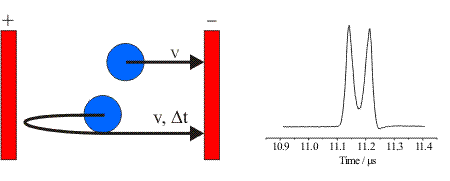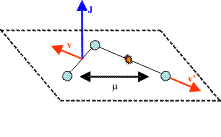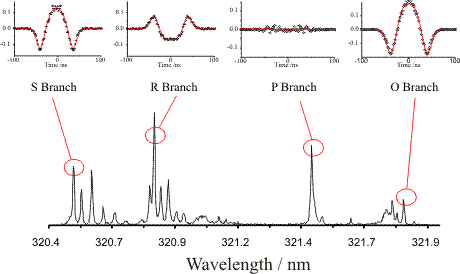Reaction Dynamics
Within this subdivision of the group, the photodissociation dynamics of atmospherically important species are investigated using resonance enhanced multiphoton ionization in conjunction with time-of-flight mass spectrometry (REMPI-TOFMS). |
|
 |
|
| The use of polarized REMPI-TOFMS probing allows the determination of the angular correlations that exist between the three vectors ? (the parent molecule transition dipole moment), v (the photofragment velocity), and J (the photofragment angular momentum) which characterize a photodissociation process. |
 |
| The shape of an experimentally observed velocity profile is directly influenced by the dissociation and probe laser polarizations, e d and e p , the spectroscopic branch probed and the velocity and angular momentum distributions. These distributions can be expressed in terms of the bipolar moments which are functions of the angles between the vectors ? , v and J . By measuring the shapes and intensities of TOF profiles taken at carefully chosen experimental geometries, the bipolar moments describing particular vector correlations may be extracted. Knowledge of the quantitative measurements of these correlations can provide insight into the topography of the excited state PES upon which dissociation occurs; for example, we expect the angle between ? and v to be related to the bond angle of the excited state of the dissociating molecule. Current research concentrates on the photodissociation of ozone within the atmospherically significant Hartley and Huggins bands. These experiments employ two tuneable laser systems; one to photolyse the ozone sample in the range 270 - 310 nm, and a second to subsequently state-selectively probe one of the photofragments via REMPI. The experimental data probing the O 2 (a 1 ? g , v = 0, J =18) product via the S (18) transition of the (2+1) REMPI scheme following photolysis of ozone at 270 nm is shown below. The red and blue lines correspond to horizontally and vertically polarized photolysis respectively with the REMPI laser polarization set to 54.7? with respect to the TOF axis. By fitting a simulated profile to the difference between the TOF profiles taken at these two experimental geometries, the bipolar moment (which characterizes the ?-v correlation) can be extracted. |
|
 |
The best fit is shown in the second figure below and returns a value of 0.67; the blue dots represent the experimental data, the red line is the simulation. |
Example experimental difference profiles and simulated fits are shown below, also for the O 2 (a 1 ? g , v = 0) product formed from 270 nm ozone photolysis and probed via transitions from different rotational branches of the same (2+1) REMPI scheme .These profiles are used to extract the moment which parameterizes the v-J correlation and are obtained by setting the polarization of the photolysis laser to 54.7? with respect to the TOF axis with the REMPI polarization switching between horizontal and vertical polarization. The dependence of the profile shape, and consequently the obtained moment on the rotational branch probed is clear. |
|
|
|
